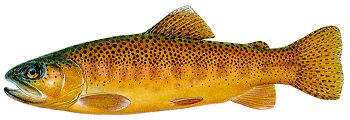
The Golden Trout

|
Only the South Fork Kern River
trout is thriving today; the others must be protected if they
are to avoid extinction. |
These quite special trout varieties of the southwest of the USA and Mexico are possibly America's oldest varieties in evolutionary terms. With one exception, they have all been brought close to extinction as pure, true-breeding forms. That exception is the South Fork Kern River Golden Trout, which is raised in fish farms and used to stock mountain streams throughout the west of the USA. The others have suffered greatly due to the introduction of non-native trout varieties that have either ousted these little trout from their home streams or interbred with them so that the true variety has become very rare.

Apache Trout

Gila Trout
Pure Apache and Gila trout populations are extremely scarce. The Gilbert Golden trout exists in its original state only on small streams above natural barriers which the introduced trout cannot pass. Pure Mexican trout occur only in the highest tributaries of their native rivers. Attempts are being made to exterminate the introduced trout from some of the streams within the traditional ranges of these wild trout varieties, and to increase the stocks of wild trout.
Most of these trout inhabit high level streams, at altitudes up to 10,000 feet above sea level. In summer the nights are very cold, though the temperature during the day might reach 30º Centigrade. And the winters are long: the growing season may last for only four or five months. Over much of the countryside, huge pine stands dominate alpine meadows of lush tall grass. On exposed rocky bluffs the plant cover consists of short, squat alpines that grow slowly through the short summer and are then hidden away through the long winters.
These uplands are drained by feeder streams and headwaters that join to make large rivers in the lower valleys and on the coastal plain. Upstream, the water is cold and well-oxygenated; but it produces only small amounts of aquatic trout foods. In fact, much of the food taken by the high level trout originates from the surrounding countryside: flies, beetles, moths and other insects that are blown on to the water. Since many of the streams and lake at these altitudes are iced up from October to June, the trout must feed, grow and breed in the short summer.

Gilbert Golden Trout
Their growth rate is very slow. At ten inches, a Gilbert or South Fork Kern River golden trout is a large fish, as is an eight inch Gila, Apache or Mexican golden trout. These varieties might grow much larger were the water more productive: one South Fork Kern River golden trout introduced into Cooks Lake, Wyoming weighed 11lbs 4oz when caught. Similarly an Apache trout caught in Bear Canyon Lake, Arizona scaled 31bs 10oz.

Mexican Golden Trout
The taxonomic status of these trout has been the subject of much controversy. Many of their distinct characteristics, for instance colour, are altered when the fish are taken from their native waters and introduced into lowland streams and lakes. Golden trout, for example, become much darker and duller in colour. This suggests that their characteristic coloration is controlled at least in part by the environment, possibly as a protective camouflage.